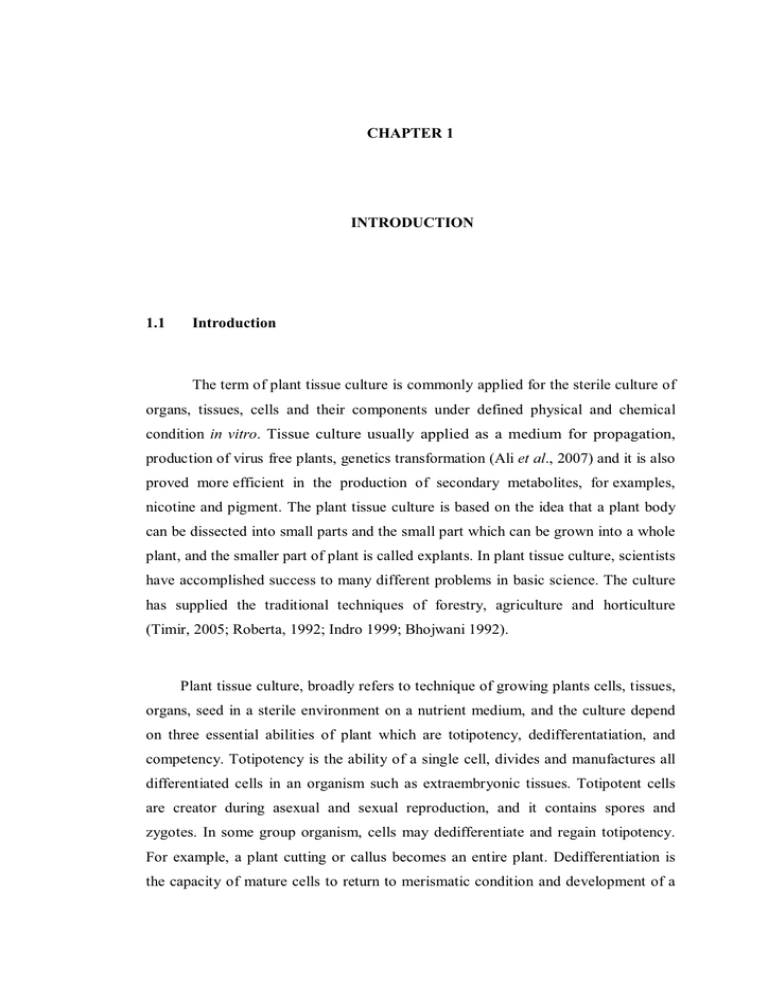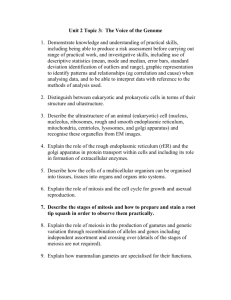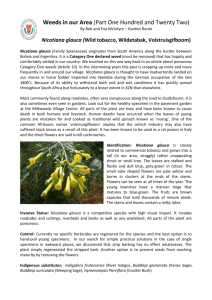CHAPTER 1 INTRODUCTION 1.1 Introduction
advertisement

CHAPTER 1 INTRODUCTION 1.1 Introduction The term of plant tissue culture is commonly applied for the sterile culture of organs, tissues, cells and their components under defined physical and chemical condition in vitro. Tissue culture usually applied as a medium for propagation, production of virus free plants, genetics transformation (Ali et al., 2007) and it is also proved more efficient in the production of secondary metabolites, for examples, nicotine and pigment. The plant tissue culture is based on the idea that a plant body can be dissected into small parts and the small part which can be grown into a whole plant, and the smaller part of plant is called explants. In plant tissue culture, scientists have accomplished success to many different problems in basic science. The culture has supplied the traditional techniques of forestry, agriculture and horticulture (Timir, 2005; Roberta, 1992; Indro 1999; Bhojwani 1992). Plant tissue culture, broadly refers to technique of growing plants cells, tissues, organs, seed in a sterile environment on a nutrient medium, and the culture depend on three essential abilities of plant which are totipotency, dedifferentatiation, and competency. Totipotency is the ability of a single cell, divides and manufactures all differentiated cells in an organism such as extraembryonic tissues. Totipotent cells are creator during asexual and sexual reproduction, and it contains spores and zygotes. In some group organism, cells may dedifferentiate and regain totipotency. For example, a plant cutting or callus becomes an entire plant. Dedifferentiation is the capacity of mature cells to return to merismatic condition and development of a 2 new growing point. And competency is described the endogenous potential of given cell to develop in a particular way (Adrinal et.al., 2003; Roberta, 1992; Bhojwani 1992). Nicotiana tabaccum belongs to Solanaceae family, and it is originated from South America. In the world, N. tabaccum is possibly the most broadly cultivated non-food crop. N. tabaccum has been used widely as medicinal herb and trade commodity in many different cultures and cultivated by human being for thousands of years. In the world, Over 33 million people engaged themselves in tobacco production. This drug crop commonly consumed as a snuff, a chew or smoke for its stimulant alkaloid, nicotine. 3 1.2 Research Objectives The objective of the research is to study sterilization method and plant regeneration system from Nicotiana tabacum TAPM 26. The establishment of this technique may be used for future research involving plant genetic engineering. 1.3 Scope of the Study 1- Development of efficient in vitro plant regeneration from Nicotiana tabaccum cotyledon by optimization of plant growth hormones, explant sizes and explant ages.




